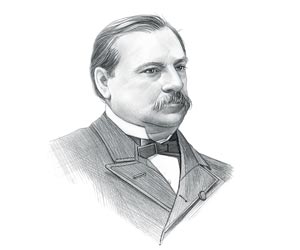|
|
|
|
|
The Klondike Gold Rush led to a stampede of hopeful prospectors to Alaska and brought substantial economic benefits to the United States of America.
Klondike Gold Rush for kids: FAQ's
for Kids When did the Klondike Gold Rush begin? The date the Klondike Gold Rush began was on August 16, 1896 on the Yukon River in Alaska - look at the Klondike Gold Rush Map. The discovery was made in Rabbit (Bonanza) Creek. When did the Klondike Gold Rush end? The Klondike Gold Rush was officially over by the Summer of 1899 (production ended in 1907). Gold was then discovered on the beaches in Nome, Alaska and the next rush began. Who discovered the Klondike Gold Rush? It was discovered by a prospector called George Washington Carmack whilst he was salmon fishing along the Klondike River in the Yukon with his Tinglish wife Kate Carmack, her brother Skookum Jim Mason and Dawson Charlie. The first claim to be filed for Bonanza creek was under George Carmack's name Where did the Klondike Gold Rush get its name? The name derives from the Klondike, which is the name of a tributary of the Yukon River which flowed through Alaska and the Yukon Territory in in north-western Canada When did the United States purchase Alaska? The Alaska Purchase was made by the United States of America from Russia in 1867 for a price of $7.2 million dollars.
Routes to the Klondike Gold Rush
Why was the Klondike Gold Rush important?
History Timeline and
Facts about the Klondike Gold Rush for Kids August 16, 1896: George Carmack (1850-1922) made his discovery on August 16, 1896 at Rabbit Creek, aka Bonanza Creek, on the Klondike River and was the first person to make a claim George Carmack made his discovery by accident when he was fishing for salmon with his wife Kate Carmack, her brother Skookum Jim Mason and a friend called Dawson Charlie. George Carmack later said that he spotted a thumb-sized nugget of gold jutting out from the creek bank and Skookum Jim claimed that he had a vision of his spirit helper that he would find wealth in the north . The veins of gold found in the area were forced to the surface by volcanic action and then worn away by the movement of rivers and streams leaving nuggets of the precious metal August 17, 1896: George Carmack stakes the first claim on Bonanza Creek at the police post at the mouth of the Forty mile River and also stakes claims for Skookum Jim and Dawson Charlie. Making a claim in the Klondike Gold Rush: A prospector would drive stakes into the ground at a measured distance apart to 'stake a claim'. They would then register the claim. Staking a claim: If the prospector left the claim for more than 3 days without good reason, another prospector could make a claim on the land A Klondike Gold Rush prospector could only stake one claim along a 500 foot (150 m) long stretch of a creek - which left the region for more miners to stake a claim which explains why a rush or stampede would occur. Claims could also be purchased. August 31, 1896: Another discovery of the Klondike Gold Rush was made on Eldorado Creek (a tributary of Bonanza) September 1896: The discovery by George Carmack was at first treated with caution but the autumn of 1896, about 50 prospectors and miners visited the area and returned with gold to the value of from $5,000 to $100,000 per person George Carmack's discovery sparked the last great western gold rush and the stampede to Alaska began. 1896: Dawson City was founded at the meeting of the Klondike and the Yukon River, and had a population of 5,000 by the end of the year and by the summer of 1898 the population would grow to 30,000 people. It was officially named in January 1897. December 1896: By this time 500 claims were located and all of Bonanza Creek had been claimed. July, 1897: A group of prospectors arrived at Seattle from the Klondike, bringing with them nuggets and dust weighing more than one ton and worth $1.5 million dollars. July 19, 1897: The Seattle Post was the first newspaper to report the Klondike Gold Rush - the news soon spreads nationwide. July 20, 1897: The very next day the stampede began as the steamship Al-Ki departed with a full deck of stampeders and 350 tons of supplies, including food, pack animals, equipment and clothing for prospectors. August 8, 1897: Another area opens up for new claims when Oliver Millett of Lunenburg staked on claim on Cheechako Hill, and hills far above Bonanza Creek June 13, 1898: Yukon is made a Territory. July 1899: The first White Pass and Yukon Route train runs from Skagway, Alaska to Carcross, Yukon. 1898: It wasn't only men who made the trip to the Klondike Gold Rush region. 8% of those living in the area were women, and in towns like Dawson City this rose to 12% Boom Towns: Boom Towns emerged such as Dawson City and Valdez and money was made by the entrepreneurs who opened stores, dance halls and saloons. 1901: Gambling and prostitution are outlawed in Yukon as a result of the Klondike Gold Rush As many as 50,000 prospectors flocked to Alaska during Klondike Gold Rush. The winter Arctic climate caused great hardship and suffering to the prospectors and many of the miners returned to their homes poorer than when they left them. Only a few hundred became wealthy men. What happened to George Carmack after the Klondike Gold Rush? He became and extremely wealthy man and retired to Vancouver. He died in 1922 at the age of 61, a respected benefactor of the city. |
| US American History |
| 1881-1913: Maturation Era |
|
|
|
|
|
First Published2016-04-19 | |||
|
Updated 2018-01-01 |
Publisher
Siteseen Limited
| ||
|
|

